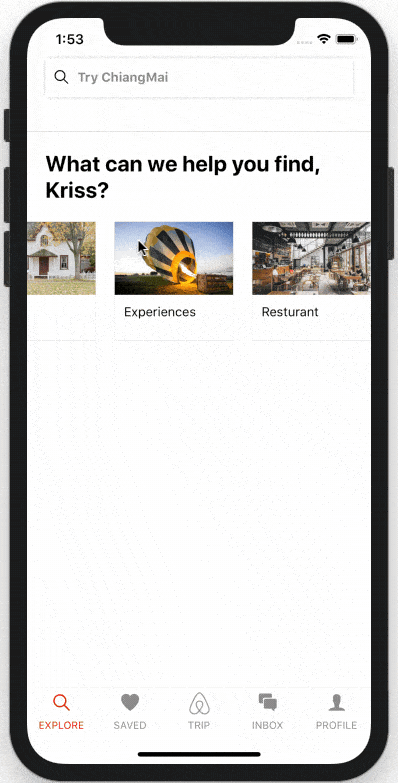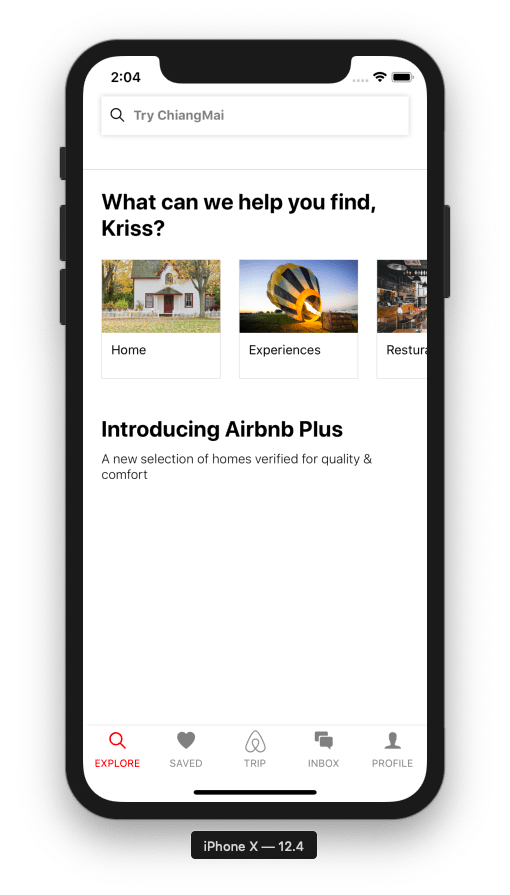[/sociallocker]This tutorial is the second part of our Airbnb Home Screen UI clone using React Native. In the previous part, we successfully implemented the bottom tab bar and the search bar at the top. This tutorial is the continuation of the same tutorial from where we left off in the last part. So, it is recommended to go through the previous part for better understanding and insight into the overall project.
As mentioned in the first part, the inspiration for the creation of this tutorial series came from React native real estate template which helps us build some amazing ready to deploy applications that anyone can use to build startups or sell the application templates. And, this part is also the continuation of coding implementations and designs from the Youtube video tutorial by Unsure programmer for the Airbnb clone.
In this part, we are going to implement two main sections to our Home Screen UI which will emphasize the recommended homes from the actual app. They are the Category section and Airbnb plus section on the Explore screen. The idea is to start by implementing the category section. Then, we will convert the category code implementation to a single component and make the component reusable. Then, we are going to move to the designing fo Airbnb section UI.
So, let us begin!!
Implementing Category Section
Importing Required Component
First, we are going to import the required components into the Explore.js file from the react-native package. The required components are ScrollView, Image and Text component which we are going to use in the Explore.js file to implement the Category section. All the imports are shown in the code snippet below:
import { View, TextInput, Text, Image, SafeAreaView, ScrollView } from "react-native";
Adding HeroText containing Description
In this step, we are going to make use of ScrollView and Text component that we imported before in the Explore.js file. The ScrollView component enables us to implement a view which users can scroll. We are going to implement it with scrollEventThrottle of value 16. Then, the ScrollView component wraps a View component with inline styles for proper view. Then, the View component wraps the Text component containing a description with some inline styles to make the description look as in the original app. The code to implement all this is provided in the code snippet below:
<ScrollView scrollEventThrottle={16}>
<View style={{ flex: 1, backgroundColor: "white", paddingTop: 20 }}>
<Text style={{ fontSize: 24, fontWeight: "700", paddingHorizontal: 20 }} > What can we help you find, Varun? </Text>
</View>
</ScrollView>
Hence, we get the following result in our emulator screen:
Adding Featured home UI in the Category section
In this step, we are going to create a feature section in which we display the image of a home along with some text at the bottom. This section is to coded below the description section. For this, we need to add a new View Component that wraps another View component in the process. Both the View components will have inline styles for the correct view. The inner View component will wrap the Image component which has the source image acquired from ‘./images’ directory. We need to bind some styles to the Image component as well to make the image look proper and nice. Then just below the View component that wraps the Image component, we need to add another View component with some inline styles. Now, this View component will wrap the Text component which will contain some text describing the image. The code to implement all this is provided in the code snippet below:
<View style={{ height: 130, width: 130, marginLeft: 20, borderWidth: 0.5, borderColor: "#dddddd" }} >
<View style={{ flex: 2 }}>
<Image source={require("../images/home.jpeg")} style={{ flex: 1, width: null, height: null, resizeMode: "cover" }} />
</View>
<View style={{ flex: 1, paddingLeft: 10, paddingTop: 10 }}>
<Text>My Home</Text>
</View>
</View>
Therefore, we will get the following result in our emulator screen:
As we can see, we have got the description as well as the image section for our category section. But, we need to add the same type of images section repeatedly to make it into the category section. How are we going to do that? The answer is to create a separate component for the Category section.
Separate Component for Category section
Here, we are going to create a separate component for our category section containing the image and text elements that we implemented in the earlier step. Separating the UI into different components is very essential in the case of React Native because it enables us to re-use the same code in the different sections as well as make the code appear clean.
So, in order to create the component, first, we need to make a separate directory to keep the components file. So, we need to create a directory called ‘./components’ into our main project directory. After that, we need to create a file called Category.js into the components directory. Then, we need to import the necessary components from the react-native package as well as the react package. Then, just create a class called Category which extends to the Component module. After that, we just need to add the Image and text section wrapped by View components that we implemented earlier in the Explore.js file into the render() function of the Category.js component file. And then, replace the Image source by prop value containing the source and tex in the Text component with another prop that we will send from the parent component. The code to implement the overall Category component is provided in the code snippet below:
import React, { Component } from "react";
import { View, Text, StyleSheet, Image } from "react-native";
class Category extends Component {
render() {
return (
<View style={{ height: 130, width: 130, marginLeft: 20, borderWidth: 0.5, borderColor: "#dddddd" }} >
<View style={{ flex: 2 }}>
<Image source={this.props.imageUri} style={{ flex: 1, width: null, height: null, resizeMode: "cover" }} />
</View>
<View style={{ flex: 1, paddingLeft: 10, paddingTop: 10 }}>
<Text>{this.props.name}</Text>
</View>
</View>
);
}
}
export default Category;
Importing Category component to Explore screen
Here, we are going to import the Category component that we implemented in the earlier step into the Explore.js file by using the code in the following code snippet:
import Category from "../components/Category";
Then, we are going to make use of that component into our Explore screen. We need to create the three blocks of Category component which will contain an image and text. We need to remember to pass the prop value named imageUri that will contain the source of image from the ‘./image’ directory, as well as a prop called nameas shown in the code snippet below:
<ScrollView scrollEventThrottle={16}>
<View style={{ flex: 1, backgroundColor: "white", paddingTop: 20 }}>
<Text style={{ fontSize: 24, fontWeight: "700", paddingHorizontal: 20 }} > What can we help you find, Kriss? </Text>
<Category imageUri={require("../images/home.jpeg")} name="Home" />
<Category imageUri={require("../images/experience.jpeg")} name="Experiences" />
<Category imageUri={require("../images/restuarunt.jpeg")} name="Resturant" />
</View>
</ScrollView>
Then, we will get the following result in our emulator screen:
As we can see, we now have three blocks of images representing the Category section.
Now, we need to show those image categories horizontally which will be scrollable as well. In order to do that, we need to add a ScrollView component with two props horizontal and showHorizontalScrollIndicator. The horizontal prop is set to true in order to show the categories horizontally and make it scrollable. And, the showHorizontalScrollIndicator is set to false in order to hide the horizontal scroll bar as shown in the code snippet below:
<View style={{ height: 130, marginTop: 20 }}>
<ScrollView horizontal={true} showsHorizontalScrollIndicator={false} >
<Category imageUri={require("../images/home.jpeg")} name="Home" />
<Category imageUri={require("../images/experience.jpeg")} name="Experiences" />
<Category imageUri={require("../images/restuarunt.jpeg")} name="Resturant" />
</ScrollView>
</View>
Therefore, we will get the following result in our emulator screen:
As we can see, we have got the horizontal categories in the emulator screen which indicates that we have successfully completed the implementation of the Category section.
Implementing Airbnb Plus Section
In this step, we are going to implement the Airbnb plus section which will introduce users to Airbnb plus features as in the real app. This is a simple step in which we just need to include a title, subtitle and an image to feature. For that, we are going to make use of components like Image, Text and View. We need to add a View wrapper with some inline styles containing two Text components that will include a title and subtitle. The Text components have their own style bindings as shown in the code snippet below:
<View style={{ marginTop: 40, paddingHorizontal: 20 }}>
<Text style={{ fontSize: 24, fontWeight: "700" }}> Introducing Airbnb Plus </Text>
<Text style={{ fontWeight: "100", marginTop: 10 }}> A new selection of homes verified for quality & comfort </Text>
Hence, we get the following result in our emulator screen:
Now, we are going to add a featured image just below the Text components. For that, we are going to use the Image component with inline styles and an image source acquired from ‘./images’ directory. The Image component is wrapped with View component bound to some inline styles to give image proper height and width as shown in the code snippet below:
<View style={{ marginTop: 40, paddingHorizontal: 20 }}>
<Text style={{ fontSize: 24, fontWeight: "700" }}> Introducing Airbnb Plus </Text>
<Text style={{ fontWeight: "100", marginTop: 10 }}> A new selection of homes verified for quality & comfort </Text>
<View style={{ width: "100%", height: 200, marginTop: 20 }}>
<Image style={{ flex: 1, height: null, width: null, resizeMode: "cover", borderRadius: 5, borderWidth: 1, borderColor: "#dddddd" }} source={require("../images/home.jpeg")} />
</View>
</View>
Therefore, we get the following result in our emulator screen: 
As we can see, the Airbnb plus section looks very appealing with the featured image. With this, we have successfully completed our second part of this tutorial series. We have successfully implemented the category section and Airbnb section into our Airbnb Home Screen UI clone.
Conclusion
This tutorial is the second part of the Airbnb Home Screen UI clone tutorial series. In this part, we continued from where we left off in the first part of this tutorial series. Here, we learned how to implement the re-usable component and use it in multiple places in the screen files. We also learned how to implement the horizontal category layout with a horizontal scroll element with a scroll bar. This portion of the tutorial was mainly about the component creation and styling of different elements. And then, we finally created the horizontal category section and an Airbnb plus section to our Home Screen UI clone using React Native.
Next Chapter here
The post Airbnb Home Screen UI Clone with React Native #2 : Recommended Homes appeared first on Kriss.
Disclosure
This post includes affiliate links; I may receive compensation if you purchase
products or services from different links provided in this article












Top comments (0)